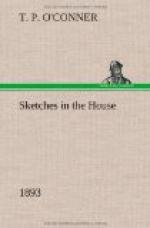[Sidenote: The bursting of the cyclone.]
Then the cyclone burst. When the sound of blows was heard; when Colonel Saunderson was seen to be in grips with another member, anger—shame—horror, took possession of everybody; some men lost their heads, determined to have their share in the fray, and for a brief second or two a solid cohort on either side—the Tories on one side, the Irish on the other—stared and glared at each other, with pallid, passion-rent, and, at the same time, horror-stricken faces—ready to descend into the abyss, and yet standing in the full consciousness of horror at its brink. William O’Brien, John Burns, Mr. Bowles, Mr. Healy, Tom Condon, a stalwart and brave Tipperary man ready for peace, ready for war, and several others—myself included—rushed to separate and remonstrate, with the result that the scene came to an end in a space which was extraordinarily short, considering the circumstances, but terribly long to those who lived through its horror. Really only three people were in that scrimmage—Mr. Austin, Colonel Saunderson and Mr. Crean. There was, I believe, some hustling, but of even that I saw little. Whether it was at this moment, or when Mr. Hayes Fisher laid hands on Mr. Logan, the hissing came from the gallery, I do not know; but it was at either of these two moments—a sound hideous, unparalleled, sufficient to bring the maddest man back to reason. And then, thinking once more that it was all over, we went into the division lobbies again.
[Sidenote: The Speaker appears.]
In common with most people, I had by this time forgotten all about Mr. Chamberlain—all about Herod—all about Judas; thinking the whole affair was over and done with; that the incident had been submerged under the row; and all I expected we had now to do was to trudge drearily and wearily through the lobbies in the long series of divisions which would precede the final passage of the Bill through Committee. It was only the wild cheering which announced the advent of the Speaker that brought me back to the House, and gave me some idea of what had gone on. If you want to understand why France welcomed Napoleon after the Terror, you had only to be in the House at that moment, and understand the sense of relief, joy, and confidence which came over it when the presence of the Speaker brought it to the sense that at last




